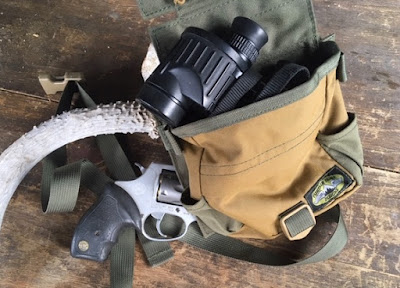 |
Chest-carry binocular case by Further Faster Design with concealed rear pocket.
(The antler is just to prop it up.)
|
From Denver television station KHOW, "Some women are opting to carry guns on Colorado trails to stay safe."
“I carry a handgun when I am hiking alone on a trail that is more
secluded, or at night, or (when) I am backpacking alone,” said Cierra
LeVan, a 27-year old teacher in Mesa County. “I do this for personal
protection and self-defense, from both potential animal and human
predators.”
LeVan is not alone; Rather than avoid hiking because they don’t have a
companion, some women are opting for more than bear spray for
protection when they hit the trails. The question of whether or not one
should carry a gun while hiking has long been a topic in online group
chats, and there is a Facebook group just for women who hike with guns. . . .
“Most women I know have been touched or grabbed by men when in the
woods. It’s too common,” said Sara C., a 35-year-old Denver business
owner who did not want her full name used for fear of being targeted. “A
creepy guy sees a girl fishing or hiking alone, tries to grab her arm
or her body … dogs and guns will scare people off.”
It's an individual choice. There are mental steps to take. Is your life worth defending, yes/no? Are you willing to not only learn to shoot, but to learn the legalities of self-defense?
Are you willing to commit to regular practice and building "muscle-memory" that will help you in an emergency? Just "buying a gun" is like a non-driver buying a car because you might need to evacuate during a floor or fire — but you just park it in the garage and leave it for three or five years — will it run when you need it? Will you remember how it works?
Then there is the law. Self-defense law varies state by state, although there are common concepts. Fire a "warning shot"? A hostile district attorney might say you committed "felony menacing" just then.
Does your state require a concealed-permit? Can you get one by taking a class and exam, or are they issued only to friends of the governor, mayor, or county sheriff?
People must be willing, since gun sales shot up this past summer — many first-time buyers, many racial minorities.
A note on the photograph: This binocular case by Further Faster Design, a Colorado firm, features a slim rear pocket with Velcro closures on the top and both sides for fast, easy access to your birding field guide or whatever. I bought mine this summer, and I like it. More information here.
This case rides high on the chest with X-straps on the back. It might fit some female body types all right, others not so much. But I had just made the photograph for another purpose, so I used it.


